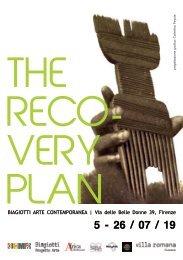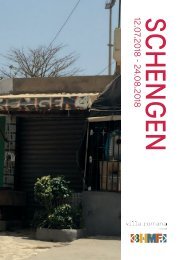The Recovery Plan: Museo MA*GA:VOl. II
Create successful ePaper yourself
Turn your PDF publications into a flip-book with our unique Google optimized e-Paper software.
The Recovery Plan_ Museo MA*GA
The Recovery Plan @ MA*GA
Young Gifted and Black Italians:
Binta Diaw, Victor Fotso Nyie, Francis Offman, Raziel Perin, Emmanuel Yoro
Gallagher
A research project of Black History Month Florence
by BHMF in collaboration with Simone Frangi
Opening Vol. II:
Binta Diaw, Nero Sangue
24 October 2020, h.16
(on reservation and subject to availability)
Starting from October MA*GA hosts an activation of The Recovery Plan, an itinerant
cultural center, founded by BHMF - Black History Month Florence and dedicated to
the promotion of Afro-descendent cultural productions in the Italian context.
During the four months of activity at Gallarate, The Recovery Plan @ MA*GA
presents, one after the other, five exhibition and research projects, carried out by the
artists Binta Diaw, Victor Fotso Nyie, Francis Offman, Raziel Perin, Emmanuel Yoro
Gallagher as the result of the first edition of YGBI - Young Gifted and Black Italians,
residency and training program dedicated to young Italian Afro-descendant artists
born from a collaboration between BHMF, OCAD - Ontario College of Art and Design
and The Student Hotel.
The Recovery Plan_ Museo MA*GA
Conceived as a collective and dialogic project, YGBI in February 2020 five Afro-
Italian artists to spend ten days together gathered in Florence working in the OCAD
studios. The studio experience was supervised and guided by international curator
Andrea Fatona, professor at OCAD, together with leaf jerlefia, curator and artist.
Each exhibition presented at MA*GA is accompanied by an Afro-descendant
researcher - Simao Amista, Jordan Anderson, Angelica Pesarini, Jessica Sartiani,
Patrick Joel Tatcheda Yonkeu - who will have the task of developing the conceptual
content of the exhibition with the artist. These collaborations will be assisted by
artist-researcher Alessandra Ferrini.
Thanks to the support of SACI- Studio Arts College International and the participation
of Penn State University and Oberlin College, the project is developed in parallel with
a series of lectures and online seminars addressed to university students.
The Recovery Plan_ Museo MA*GA
24 October 2020 to 8 November 2020
The Recovery Plan @ MA*GA - Vol. II
Binta Diaw, Nero Sangue
Associate researcher: Angelica Pesarini
Nero Sangue is an installation that reflects on the systematic violence experienced
by the black bodies of migrants and workers in tomato fields. The exhibition was
born from research that elaborates a link between the organicity of the tomato and
that of the black body. The latter, harvesting raw material, in conditions of extreme
precariousness and vulnerability, becomes part of a loop: a vortex that overwhelms
and engages physically and mentally in a state of "mechanical exploitation".
With Angelica Pesarini, an interest was developed in bringing out the intense
connection that unites the colonial, fascist Italian past and the current racial,
physical, verbal and psychological violence suffered by migrants today. The research
is sustained by a re-reading of the tragic events of recent years, which see multi-digit
numbers of migrants dead and killed by a system under the name of the Italian
Nation.
*The project is realized with the support of Ricola
The Recovery Plan_ Museo MA*GA
Text by Angelica Pesarini
"Nero Sangue" was born from an intense collaboration of exchanges and conversations
with the artist Binta Diaw.
At the center of "Nero Sangue" resides the Black Body, immersed in the logic of
exploitation and control in which labor in tomato fields evokes practices of modern
slavery. As James Baldwin states, the historical production of the Black Body is imbued
with pain and terror, it is the fanonian expérience vécue du Noir, an experience lived in a
state of chronic uncertainty, which sees the image of one's own body denied and
crystallized by the white gaze.
This context is framed by colonialism and fascism that dehumanize the Black Body by
portraying it immersed in vegetation, from behind, sitting, surrounded by cattle. Images
from which the will to show a supposed physical, mental and technological superiority of
the "Italian race" emerges.
The blood thus becomes a central element of the narrative: the shed and honored blood
of the "fallen", those who die to defend the race and to give Italy that aguishly coveted
place in the sun through the misappropriation of land and resources, the creation of
concentration camps, the use of torture and chemical weapons. Blood, however, is also
what unites and gives citizenship to black children born in colony, ius sanguinis, the right
to blood. Blood is, today, the exclusive element, the one that prevents thousands of
people born/arrived and raised in Italy from being citizens of this country.
And blood is also the blood shed by the Black Body, bent in the fields picking tomatoes,
bodies that die for lack of drinking water, for lack of health care, burned in fires caused
by dangerous situations in dilapidated housing, or for illegal working conditions.
Black, Body, Red, Blood.
The Black Body has historically shown us "fugitivity" (Moten and Harney) as a weapon of
resistance, as a means to break chains which are not only physical. The body is used as
a means to carve out their resistance. Escape, fight, poisoning, secretly spoken and
deliberately carved languages, self-inflicted mutilations: the strategies of black resistance
pass from the body that from organic matter becomes a political body on which to
inscribe indelible messages. A body under threat of constant loss, and yet, a body that
exposes itself and resists.
This is the legacy of our ancestors. The right to have a Body.
















